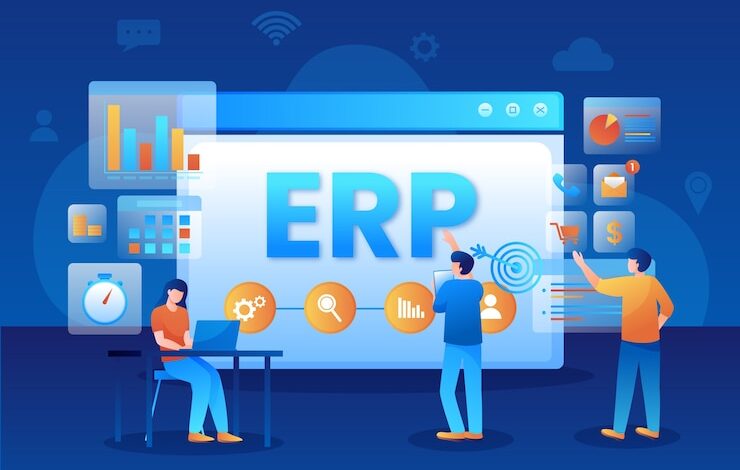
In today’s fast-paced business environment, efficiency and growth are paramount. For small business owners, enterprise managers, and tech enthusiasts, integrating advanced tools like Enterprise Resource Planning (ERP) systems can be a game-changer. This blog post will explore the various facets of ERP systems, why they are crucial for business success, and how to implement them effectively.
Introduction
Navigating the complexities of running a business often requires deft coordination of multiple functions, from finance to supply chain management. ERP systems offer a solution by streamlining these processes into a unified platform. This post will break down what an ERP system is, its benefits, key considerations when choosing one, and best practices for implementation.
What is an ERP?
An ERP, or Enterprise Resource Planning system, is a comprehensive software platform designed to integrate various business functions into a single unified system. It facilitates the flow of information between different departments, ensuring that data is consistent, up-to-date, and accessible in real-time. Key components typically include modules for finance, human resources, manufacturing, and supply chain management.
The core functionality of an ERP system lies in its ability to automate and standardize business processes, thus improving operational efficiency. For instance, an ERP can automate inventory management by syncing sales data with stock levels, thereby reducing manual errors and ensuring that products are always available.
Beyond automation, ERPs also offer powerful data analytics capabilities. These systems can generate real-time insights and reports, helping businesses make informed decisions quickly. Integration capabilities further amplify their utility, allowing businesses to connect existing software and systems seamlessly.
The Benefits of Using an ERP
Implementing an ERP system can bring about several significant advantages:
Improved Operational Efficiency and Productivity
ERP systems automate routine tasks, reducing the need for manual input and decreasing the margin for error. This leads to more efficient operations and allows employees to focus on higher-value activities, boosting overall productivity.
Enhanced Data Security and Accuracy
With centralized data storage, ERPs provide robust security measures to protect sensitive information. This centralization also ensures data consistency and accuracy across the organization, eliminating the discrepancies that often arise from using disparate systems.
Better Decision-Making Through Real-Time Insights
ERP systems offer real-time reporting and analytics, providing business leaders with the insights needed to make informed decisions. Whether it’s forecasting demand or tracking financial performance, these insights are invaluable for strategic planning.
Cost Savings and ROI in the Long Run
While the initial investment in an ERP system can be substantial, the long-term savings from improved efficiency, reduced errors, and better decision-making typically result in a high return on investment (ROI).
Considerations for Choosing the Right ERP
Selecting the right ERP system for your business involves several critical considerations:
Needs Assessment for Your Business
Begin by conducting a thorough needs assessment to identify the specific functionalities your business requires. This will help you choose an ERP system that aligns with your operational goals.
Scalability and Flexibility of the ERP Solution
Choose an ERP that can scale with your business as it grows. Flexibility is also crucial, ensuring the system can adapt to changing business needs and integrate new functionalities as required.
Integration Capabilities with Existing Software and Systems
Ensure that the ERP system you choose can seamlessly integrate with your existing software and systems. This interoperability is essential for maintaining continuity and maximizing the utility of your new ERP.
Vendor Reputation and Support Services
Research the reputation of potential ERP vendors and the support services they offer. Reliable customer support and ongoing maintenance are vital for the successful implementation and operation of your ERP system.
Implementation Best Practices
Successfully implementing an ERP system involves several best practices:
Planning and Preparation for a Smooth Transition
Detailed planning and preparation are crucial for a smooth ERP implementation. This involves setting clear objectives, timelines, and resource allocation to ensure all aspects of the transition are covered.
User Training and Change Management Strategies
Invest in comprehensive user training to ensure your team can effectively utilize the new system. Change management strategies should also be in place to address any resistance and facilitate a smooth transition.
Post-Implementation Evaluation and Adjustments
After implementation, continuously evaluate the system’s performance and make necessary adjustments. This iterative process helps optimize the ERP’s functionality and ensures it continues to meet your business needs.
Case Studies
Real-world examples can illustrate the tangible benefits of ERP systems:
Small Business Success Story
A small manufacturing firm implemented an ERP system to streamline its supply chain management. Within six months, the company reported a 30% reduction in inventory costs and a 20% increase in on-time deliveries.
Enterprise Success Story
A large retail enterprise used an ERP to integrate its finance, HR, and sales departments. The result was a 25% improvement in financial reporting accuracy and a 15% increase in employee productivity.
Conclusion
Incorporating an ERP system into your business operations can significantly enhance efficiency, data accuracy, and decision-making capabilities. For small business owners, enterprise managers, and tech enthusiasts, the benefits of ERP systems far outweigh the initial investment. By following best practices for implementation and choosing the right system, your business can unlock unprecedented growth and operational excellence.


